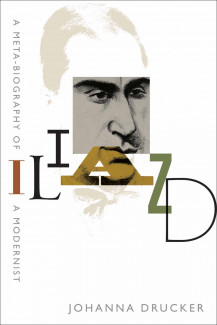
Johns Hopkins UniversityEst. 1876
America’s First Research University
Now Browsing:
Reflections on “Iliazd: A Meta-Biography of a Modernist”

I first became aware of the work of Ilia Zdanevich while searching libraries and archives to study the typography of 20th-century avant-garde Dada and Futurist poets through their manuscripts and printed ephemera. But my research on Iliazd brought me into connection with living witnesses to his life and work, a remarkable opportunity made possible through his widow.
I met Hélène Zdanevich in Paris in January 1985, and that first rendezvous, described in the early pages of Iliazd: A Meta-Biography of a Modernist, led to this project. She lived in the tiny one-room apartment with a studio that had been Iliazd’s home from the mid-1930s until his death. On the walls of that small room, where we spoke in the flickering light of a modest gas grate, drawings by Natalia Goncharova, Robert Delaunay, Alberto Giacometti, and Pablo Picasso loomed through the shadows. I was sitting in a private collection of someone who had lived and breathed modern art. Madame Iliazd wanted a biography written, and she invited me to work in the personal archive still stored in the space that had been his studio.
Through Madame I made the acquaintance of individuals who had been companions to Iliazd’s work and life—artists, poets, fellow Russian emigrés, critics, and even figures with whom he had quarreled—such as the remaining Lettrist poets. In addition, several scholars intently engaged with Iliazd’s poetics were part of the network supported by the efforts of Madame Iliazd in making sure that this artistic legacy achieved the appropriate recognition.
The stories of those encounters and the reflections they prompted on the challenges of writing a biography are entwined in this study of a multi-talented poet-designer whose career spanned the 20th century from his earliest Russian Futurist publications in the 1910s until his death in Paris in 1975. Known professionally by the contracted form of his name, Iliazd built a reputation as the editor-publisher-designer of deluxe livres d’artistes produced with collaborators whose names read like a who’s who of European modern art: Pablo Picasso, Max Ernst, Joan Miro, and many others. An important mid-century accomplishment was The Poetry of Unknown Words, an anthology he edited, designed, typeset, and published in 1949—the first collection of radically experimental visual and sound poetry from the early 20th century.

Iliazd was unique among writers and publishers for having apprenticed to the printing trade and learned typesetting on the shop floor in his native Tiflis, Georgia, in the late 1910s. Custom and class structure generally prevented such activity, as the closest most artists—typically members of the bourgeoisie—got to manual labor was in acquiring the studio skills of the fine arts. While modern Russian artists seized the opportunity to make use of production tools like mimeo, rubber stamps, and collage for their publications, Iliazd acquired his skills among the professionals of the printing industry. This meant that his conception of book design was directly informed by experience—which shows dramatically from the first typographically scored complexities of earliest publications through the final editions.
I drew on my own background as a letterpress printer and book artist in analyzing Iliazd’s approach to production. But I am also interested in the historical specificity of scholarly authorship. Begun in the mid-1980s, when modernism was already being dismantled through the criticism of post-modern theory, this project was finished in 2019, when our appreciation of European modern art and literature is qualified by rethinking its place in a global cultural network. The idea of the parallax introduced by this time shift is an insight owed to the long gestation period. Modernism looked very different three decades ago than it does now, and my own assessments of Iliazd’s claims and contributions have shifted.
The work of Iliazd has long been an object of interest, but materials in English have been extremely limited. This is the first full-length biography published in any language. I have drawn on the collection of notes, archival materials, interviews, copies of manuscripts and other original documents that I accumulated in the several years I worked with Hélène. That material cannot be replicated now—many of the figures whose comments annotated my research are gone, above all, Hélène herself, the conscientious advocate for this biography.
Those already acquainted with the deluxe editions of Iliazd will find this book useful in documenting the life from which his productions emerged. Scholars concerned with the long trajectory of modernism—from its radical avant-garde beginnings through to its canonical consolidation will find that focus on an individual career provides insights into the connections between history and lived experience. A broader audience interested in biographical work should be provoked by the discussion of the relations between evidence and narrative, boundaries of privacy and research, and the tensions between character study and documentation.
Order Iliazd: A Meta-Biography of a Modernist – published on December 15, 2020 – at the following link: https://jhupbooks.press.jhu.edu/title/iliazd
Johanna Drucker is the Distinguished Breslauer Professor of Bibliographical Studies in the Department of Information Studies at the University of California, Los Angeles. She is the author of Iliazd: A Meta-Biography of a Modernist and The General Theory of Social Relativity and Diagrammatic Writing.

I met Hélène Zdanevich in Paris in January 1985, and that first rendezvous, described in the early pages of Iliazd: A Meta-Biography of a Modernist, led to this project. She lived in the tiny one-room apartment with a studio that had been Iliazd’s home from the mid-1930s until his death. On the walls of that small room, where we spoke in the flickering light of a modest gas grate, drawings by Natalia Goncharova, Robert Delaunay, Alberto Giacometti, and Pablo Picasso loomed through the shadows. I was sitting in a private collection of someone who had lived and breathed modern art. Madame Iliazd wanted a biography written, and she invited me to work in the personal archive still stored in the space that had been his studio.
Through Madame I made the acquaintance of individuals who had been companions to Iliazd’s work and life—artists, poets, fellow Russian emigrés, critics, and even figures with whom he had quarreled—such as the remaining Lettrist poets. In addition, several scholars intently engaged with Iliazd’s poetics were part of the network supported by the efforts of Madame Iliazd in making sure that this artistic legacy achieved the appropriate recognition.
The stories of those encounters and the reflections they prompted on the challenges of writing a biography are entwined in this study of a multi-talented poet-designer whose career spanned the 20th century from his earliest Russian Futurist publications in the 1910s until his death in Paris in 1975. Known professionally by the contracted form of his name, Iliazd built a reputation as the editor-publisher-designer of deluxe livres d’artistes produced with collaborators whose names read like a who’s who of European modern art: Pablo Picasso, Max Ernst, Joan Miro, and many others. An important mid-century accomplishment was The Poetry of Unknown Words, an anthology he edited, designed, typeset, and published in 1949—the first collection of radically experimental visual and sound poetry from the early 20th century.

Iliazd was unique among writers and publishers for having apprenticed to the printing trade and learned typesetting on the shop floor in his native Tiflis, Georgia, in the late 1910s. Custom and class structure generally prevented such activity, as the closest most artists—typically members of the bourgeoisie—got to manual labor was in acquiring the studio skills of the fine arts. While modern Russian artists seized the opportunity to make use of production tools like mimeo, rubber stamps, and collage for their publications, Iliazd acquired his skills among the professionals of the printing industry. This meant that his conception of book design was directly informed by experience—which shows dramatically from the first typographically scored complexities of earliest publications through the final editions.
I drew on my own background as a letterpress printer and book artist in analyzing Iliazd’s approach to production. But I am also interested in the historical specificity of scholarly authorship. Begun in the mid-1980s, when modernism was already being dismantled through the criticism of post-modern theory, this project was finished in 2019, when our appreciation of European modern art and literature is qualified by rethinking its place in a global cultural network. The idea of the parallax introduced by this time shift is an insight owed to the long gestation period. Modernism looked very different three decades ago than it does now, and my own assessments of Iliazd’s claims and contributions have shifted.
The work of Iliazd has long been an object of interest, but materials in English have been extremely limited. This is the first full-length biography published in any language. I have drawn on the collection of notes, archival materials, interviews, copies of manuscripts and other original documents that I accumulated in the several years I worked with Hélène. That material cannot be replicated now—many of the figures whose comments annotated my research are gone, above all, Hélène herself, the conscientious advocate for this biography.
Those already acquainted with the deluxe editions of Iliazd will find this book useful in documenting the life from which his productions emerged. Scholars concerned with the long trajectory of modernism—from its radical avant-garde beginnings through to its canonical consolidation will find that focus on an individual career provides insights into the connections between history and lived experience. A broader audience interested in biographical work should be provoked by the discussion of the relations between evidence and narrative, boundaries of privacy and research, and the tensions between character study and documentation.
Order Iliazd: A Meta-Biography of a Modernist – published on December 15, 2020 – at the following link: https://jhupbooks.press.jhu.edu/title/iliazd
Johanna Drucker is the Distinguished Breslauer Professor of Bibliographical Studies in the Department of Information Studies at the University of California, Los Angeles. She is the author of Iliazd: A Meta-Biography of a Modernist and The General Theory of Social Relativity and Diagrammatic Writing.

Login to View & Leave Comments
Login to View & Leave Comments


